 |
renaissance guitar
example : custom made by Peter Forrester, UK 1983, after picture
in a book by Mersenne 1636 |
L=740 B=205 H=85mm
scale 510mm |
|
|
|
| renaissance guitar This
is the early guitar, used in the 16th century. Only a
few books exist with music for it - most of it is in lute-playing
style, but then using only 4 courses. It has a lute-like tuning,
however omitting the top string.
The renaissance guitar is much smaller than
a normal guitar (or the vihuela from the same period
used in Spain), and also thinner. Some had a somewhat rounded
back and the waist was slimmer.
The pegbox was open and had seven friction pegs : three on the
right and four on the left side. Often the pegbox had a scroll
or an animal head carved on it.
The soundhole was often filled with a rosette,
made of several layers of delicately cut parchment. It had gut
strings in 4 courses (the first single, the rest double) and no
raised fingerboard. The frets were tied-on gut string.
The strings were tied to a rather small bridge, glued to the front.
The tuning would be gg' c'c' e'e' a'.
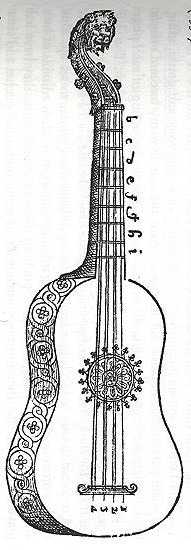 |
picture from the
book by Mersenne, |
|
|
| top |
|
 |
baroque guitar
example : custom made by Hopf guitar factory, Germany 1979,
after unknown example |
L=960 B=280 H=90mm
scale 620mm |
|
|
|
baroque guitar
This is the instrument of the 17th and 18th century,
the instrument of players/composers like Visee, Sanz, Corbetta.
The baroque guitar had 5 double gut string
courses (first string single), with tied-on gut frets. The soundhole
was always filled with a delicate rosette, made of several layers
of parchment. The bridge usually had a kind of "mustache"
and the edges of the front were decorated, like with black and
white blocked purfling. The fingerboard was flush with the front.
One of the usual tunings was re-entrant : aa d'd'
gg bb e'e' or aa d'd gg bb e'e'.
The sound is quite thin, lacking the basses, and
the music was a combination of chord strumming and single note "fingerpicking".
The notation was in tablature, with each composer using his own
style of notating the ornamentation.
Famous builders of baroque guitars were
Voboam and Sellas, of which many beautiful decorated guitars have
survived.
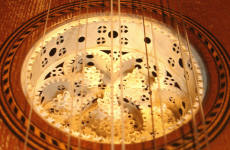 |
As was usual in
the 17th C, the soundhole has several layers of a delicately
cut parchment rosette. This rosette was later made for this
baroque guitar by Harvey Hope.
For more beautiful rosettes see Roses. |
|
|
| top |
|
 |
chitarra
battente
example : custom made after Sellas instrument
by Martin de Witte, NL 2000 |
L=910 B=240 H=130mm
scale 590mm |
|
|
| chitarra battente This
is a special type of baroque guitar, used for strumming
chords.
The chitarra battente was mainly used in
Italy, hence the Italian name.
In fact there still exists a similar instrument (with the same
name) in Italy (see Europe
South).
Usually the back was made quite vaulted, and the
sides sometimes higher than on other guitars, to get as much sound
producing body as possible.
The chitarra battente did not have the customary
gut strings, but used 5 courses of thin metal strings, often even
with three strings per course. To stand the force of so many metal
strings, the bridge was not glued to the front, but the strings
ran over the loose bridge, to pins at the end of the body. To strengthen
the construction, the part of the front lower than the bridge was
made slanting (like on an Italian mandolin).
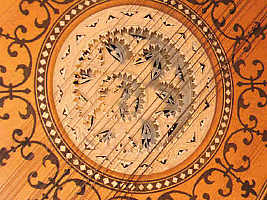 |
As was usual in the
17th C, the soundhole has several layers of a delicately cut
parchment rosette, while the front is decorated with filled-in
carvings. The fingerboard has inlayed squares of bone (originally
ivory) with rural landscapes etched in them. |
The example instrument (after an instrument in
the GemeenteMuseum in The Hague) has 14 strings, and proves to be
difficult to keep in tune. There is hardly any music for it - as it
was just used for strumming chords to accompany singing. It gives
a very full rich sound, however lacking any basses.
Playing normal baroque guitar music on it is more difficult than on
the usual baroque guitar. |
|
| top |
|
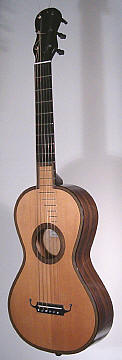 |
romantic guitar
example : custom made after Grobert guitar by Martin de Witte, NL
1998 |
L=920 B=295 H=75mm
scale 635mm |
| |
|
| romantic
guitar
At
the end of the 18th century the guitar started to change : the
quite delicate guitar with 5 double courses gave way
to a somewhat more robust type of guitar with 6 strings.
Only in Spain the 5 course guitar first got an extra
(6th) bass course; the rest of Europe went more or less straight
from the 5 double courses to 6 single strings.
Other changes were the use of metal frets instead
of the tied-on gut frets, a longer fingerboard, and inside some
more struts to strenghten the body. The friction pegs were slowly
on replaced by some mechanical tuners. Decoration became scarse
and mainly limited to the purfling around the edge of the body.
The parchment carved rosette inside the soundhole was replaced
by just some decoration around the soundhole (which now looked
quite empty...).
This model, with the pegbox in a figure of eight
shape that resembles the shape of the guitar itself,
still has the friction pegs. The bridge has some remnants of a
mustache and the strings are fixed with bridge-pins : small peg-like
items that make the pulling force of the strings go right to the
wood of the front, instead of via the glue of the bridge.
The strings were made of gut, in the now familiar tuning E A d g
b e'.
This model was mainly made in France and Italy.
For lots of information about this type of guitar
see earlyromanticguitar.com.
|
|
| top |
|
 |
Stauffer guitar
example : custom made after Stauffer Legnani guitar by Martin de
Witte, NL 2000 |
L=950 B=305 H=80mm
scale 620mm |
| |
|
| Stauffer guitar In
Austria the guitarmaker Stauffer worked in the early 1800 together
with the Italian guitar viruoso Legnani to design a new type of
guitar.
This model has a flat peghead in the shape of a
sideways curl of a violin (somewhat resembling the modern Fender
tuning head), on which (on the back) a special (closed) metal
tuning machine was fixed, with all 6 tuners on the left side.
A similar device is still used on tamburitzas (see EuropeEast).
The neck was fixed to the body with only one special
screw (the fingerboard was free from the soundboard), which could
be turned with a key, and this also adjusted the angle of the neck,
making it easy to adjust the hight of the strings (the "action").
The bridge still has some remnants of a mustache, and the strings
are fixed with bridge-pins.
This type of guitar was mainly made around
Vienna. One of the apprentices of Stauffer was C.F. Martin, who
later went to USA to make guitars, which was the beginning
of the famous Martin guitar factory.
For lots of information about this type of guitar
see earlyromanticguitar.com.
|
|
| top |
|
 |
Panormo
guitar
example : from website guitarsalon.com |
L= B= H=mm
scale ~620mm |
| |
|
| Panormo
guitar In England the (baroque)
guitar had never been very popular, until around 1800 the
family of Panormo (who were Italian instrumentmakers) came to
London. Here they became quite famous, making guitars
in the Spanish tradition.
Their main model shows the nowadays more or less
standard way of machine heads in a double slotted open peghead,
and a slightly raised fingerboard. There are still some remnants
of a moustache on both sides of the bridge.
For lots of information about this type of guitar
see earlyromanticguitar.com.
|
|
| top |
|
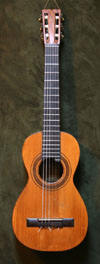 |
terz
guitar
example : picture from website Guitarcentre |
L= B= H=mm
scale ~550mm |
| |
|
terz
guitar
The terz guitar is
a small size (classical) guitar, which is tuned a minor
third higher than a normal guitar (top string in g'). The higher
tuning of the gut or nylon strings gives it a bright tone. Of
course to get the same tuning you could also put a capodastre
on the 3th fret of a normal guitar.
They are often sold as "child's
guitar", because of the smaller size. It is similar in size
to the requinto of Spain and Mexico (see
AmericaNorth).
The terz guitar was popular in Vienna
round 1800 and especially with composers like Giuliani and Diabelli.
There is now a kind of revival in USA with small
size steel string guitars, also using the name "terz
guitar".
For lots of information about this type of guitar
see earlyromanticguitar.com.
|
|
| top |
|
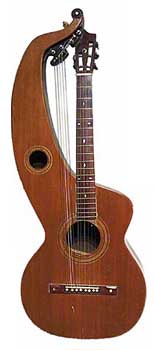 |
harp guitar
example : picture from website harpguitars.net |
L= B= H=mm
scale mm |
| |
|
| harp
guitar The harp guitar
is in fact a normal classical guitar (with 6 fretted
strings) that have an extension to the body or to the neck (or
even a separate neck) with a number of extra strings (3 to 9)
that are only played unfretted, and in general are meant for bass
notes. Player/composers like Coste often used this instrument.
The Austrian schrammel gitarre is a harp guitar
(see EuropeEast)
This arrangement makes the harp guitar
different from a multi-string guitar, with 7, 8, 9 or
10 strings, that all can be fretted (see miscellaneous).
Usually the string length of the bass strings is
more or less the same length as the fretted strings. Each maker
designed his own model and they had quite a variety of solving
the problem how to design the extra neck and fix the extra strings.
For an extensive overview of all the many different kinds of harp
guitars, see : harpguitars.net
|
|
| top |
|
 |
lyre guitar
example :
picture from website
National Music Museum |
L= B= H=mm
scale mm |
|
|
| lyre
guitar The lyre guitar
became popular in Europe during a short period : mainly 1785 -
1820, with a peak between 1805 - 1810. This instrument was more
a piece of art - heavily inspired by Classisme (based on ancient
Greece and Rome) - than a musical instrument.
Because of their larger bodies they were supposed
to have more volume. It is of notice that they always had 6 single
strings in a period that that was not yet common practice on all
guitars.
The lyre guitar had on both sides of the neck a body
extention (like arms), often ending in some way with a (metal)
device that joined up with the tuning head. Many had a normal
single central soundhole, but also two rosettes were common. Most
instruments were nicely decorated. Tuning was like a normal 6-string
guitar.
The lyre guitar was mainly played by ladies
(of standing). Normal guitar music could be played on
it, but due to the shape of the wings, playing was not really
comfortable.
The shortlived rage has only provided us with a wide range of
pieces of art.
For lots of details about lyre guitars
see harpguitars.net.
|
|
| top |
|
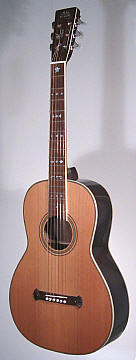 |
parlor guitar
example : Washburn reissue 1890, bought 1997 |
L=970 B=345 H=100mm
scale 630mm |
| |
|
| parlor
guitar In the second half of the
19th century (some) people got more leasure time and played guitar
for their own enjoyment - although the banjo and the
mandoline were still far more popular.
In the USA some postorder firms (like Lyon and Healy) sold thousands
of this type of guitar - quite large in their time, but
still small compared with modern size guitars. As they
were mainly used at home, they were known as parlor guitars.
The body shape was more or less fixed. The bridge
had small (square) extensions on both sides (usually decorated),
and the strings were fixed with bridge pins. It had a simple inlay
rosette around the soundhole and tuning machines (on a slotted
or a flat peghead). The fingerboard was raised above the front.
The strings were originally still made of gut, later of steel.
|
|
| top |
|
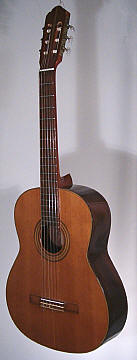 |
classical guitar
example :
Ibanez model 373,
bought 1972 |
L=1010 B=345 H=100mm
scale 650mm |
| |
|
classical
guitar
Around 1850 the Spanish guitarmaker Torres designed
the type of guitar that is now standard for playing classical
guitar music. It is also called Spanish guitar.
The main characteristics are the tuning machines
on a double slotted open peghead, 6 single (gut, later nylon)
strings, a wide fingerboard raised above the soundboard, a special
heel (to connect the neck to the body), and a flat square bridge
with a (bone) saddle. Inside the body is a special way of (fan)bracing
to strengthen the soundboard.
Compared with the old baroque guitar,
there is not much decoration on this type of guitar,
but those few bits are usually the only items by which a maker
can be recognized : the shape of the top of the peghead, the rosette
inlay around the soundhole, the inlay strip on the bridge and
on the join in the middle of the back. All the rest (like the
dimensions and proportions of the body) is since Torres more or
less fixed.
Tuning is E A d g b e' and playing is in 'classical
style' : plucking each string separate with the fingers and thumb. |
|
| |
|
|
|













